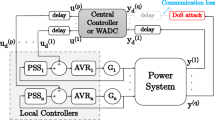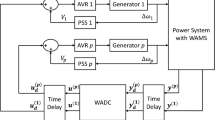Abstract
Use of phasor measurement units in power systems has emerged new real-time control techniques such as wide area damping control (WADC). WADC systems were shown to be very effective if the network induced time delay is handled properly. Delay compensation techniques based on constant delay assumption lack robustness and many of techniques assuming time variant delay are not suitable for real-time systems due to resulting complex structures of controllers or the strict requirements imposed on signal transmission. Handling time delay adaptively by switching among a set of lead controllers to provide required compensation based on online measurements shown to be both practical and robust. Here, frequent switching between the controllers should be avoided in order to avoid sustained oscillations. Putting a limit on switching period hinders proper delay compensation. This paper presents algorithms for adaptive selection of switching period based on the condition of network traffic in order to provide near real-time delay compensation. Network activity is observed by a metric defined as the difference of the average time delays measured in consecutive intervals. Based on this metric, switching period is decreased adaptively when time delay characteristics change fast. For slow changing dynamics of time delay, the algorithm picks longer switching periods in order to prevent sustained oscillations. Performance evaluation of the proposed algorithms are conducted by a WADC system designed for two-area, four-machine benchmark model. The algorithms are shown to be successful in tracking the fast changing dynamics of a communication network through simulations.











Similar content being viewed by others
References
Pal B, Chaudhuri B (2006) Robust control in power systems. Springer, Berlin
Paserba J et al (1996) Analysis and control of power system oscillation. CIGRE Spec Publ 38(07):6–14
Larsen EV, Sanchez-Gasca JJ, Chow JH (1995) Concepts for design of facts controllers to damp power swings. IEEE Trans Power Syst 10(2):948–956
Chow JH, Sanchez-Gasca JJ, Ren H et al (2000) Power system damping controller design-using multiple input signals. IEEE Control Syst Mag 20(4):82–90
Zhao Q, Jiang J (1995) Robust SVC controller design for improving power system damping. IEEE Trans Power Syst 10(4):1927–1932
Liu Q, Vittal V, Elia N (2006) LPV supplementary damping controller design for a thyristor controlled series capacitor (TCSC) device. IEEE Trans Power Syst 21(3):1242–1249
Snyder AF, Hadjsaïd N, Georges D et al (1998) Inter-area oscillation damping with power system stabilizers and synchronized phasor measurements. In: POWERCON’98. 1998 International Conference on Power System Technology. Proceedings (Cat. No. 98EX151). IEEE, pp 790–794
Cai LJ, Erlich I (2005) Simultaneous coordinated tuning of PSS and facts damping controllers in large power systems. IEEE Trans Power Syst 20(1):294–300
Ramírez JM, Dávalos RJ, Valenzuela V (2000) Coordination of facts-based stabilizers for damping oscillations. IEEE Power Eng Rev 20(12):46–49
Chow JH, Ghiocel SG (2012) An adaptive wide-area power system damping controller using synchrophasor data. In: Control and optimization methods for electric smart grids. Springer, pp 327–342
Aboul-Ela ME, Sallam A, McCalley JD et al (1996) Damping controller design for power system oscillations using global signals. IEEE Trans Power Syst 11(2):767–773
Stahlhut JW, Browne TJ, Heydt GT et al (2008) Latency viewed as a stochastic process and its impact on wide area power system control signals. IEEE Trans Power Syst 23(1):84–91
Tomsovic K, Bakken DE, Venkatasubramanian V et al (2005) Designing the next generation of real-time control, communication, and computations for large power systems. Proc IEEE 93(5):965–979
Hauser CH, Bakken DE, Bose A (2005) A failure to communicate: next generation communication requirements, technologies, and architecture for the electric power grid. IEEE Power Energy Mag 3(2):47–55
Dotta D, e Silva AS, Decker IC (2008) Wide-area measurements-based two-level control design considering signal transmission delay. IEEE Trans Power Syst 24(1):208–216
Chaudhuri B, Majumder R, Pal BC (2004) Wide-area measurement-based stabilizing control of power system considering signal transmission delay. IEEE Trans Power Syst 19(4):1971–1979
Majumder R, Chaudhuri B, Pal B (2007) Implementation and test results of a wide-area measurement-based controller for damping interarea oscillations considering signal-transmission delay. IET Gener Transm Distrib 1(1):1–7
Darabian M, Bagher A (2021) Design of adaptive wide-area damping controller based on delay scheduling for improving small-signal oscillations. Int J Electr Power Energy Syst 133:107–224
Bai F, Zhu L, Liu Y et al (2016) Design and implementation of a measurement-based adaptive wide-area damping controller considering time delays. Electr Power Syst Res 130:1–9
Tang K, Venayagamoorthy GK (2016) Adaptive inter-area oscillation damping controller for multi-machine power systems. Electr Power Syst Res 134:105–113
Beiraghi M, Ranjbar A (2016) Adaptive delay compensator for the robust wide-area damping controller design. IEEE Trans Power Syst 31(6):4966–4976
Cheng L, Chen G, Gao W et al (2014) Adaptive time delay compensator (ATDC) design for wide-area power system stabilizer. IEEE Trans Smart Grid 5(6):2957–2966
Wu H, Heydt GT (2003) Design of delayed-input wide area power system stabilizer using the gain scheduling method. In: 2003 IEEE Power Engineering Society General Meeting (IEEE Cat. No. 03CH37491). IEEE, pp 1704–1709
Zhang X, Lu C, Xie X et al (2015) Stability analysis and controller design of a wide-area time-delay system based on the expectation model method. IEEE Trans Smart Grid 7(1):520–529
Zhang S, Vittal V (2014) Design of wide-area damping control robust to transmission delay using \(\mu \)-synthesis approach. In: 2014 IEEE PES General Meeting Conference & Exposition. IEEE, pp 1–5
Prakash T, Singh VP, Mohanty SR (2019) A synchrophasor measurement based wide-area power system stabilizer design for inter-area oscillation damping considering variable time-delays. Int J Electr Power Energy Syst 105:131–141
Yao W, Jiang L, Wen J et al (2014) Wide-area damping controller for power system interarea oscillations: a networked predictive control approach. IEEE Trans Control Syst Technol 23(1):27–36
Heniche A, Kamwa I (2008) Assessment of two methods to select wide-area signals for power system damping control. IEEE Trans Power Syst 23(2):572–581
Chen G, Sun Y, Venkatasubramanian VM et al (2012) Wide area control framework design considering different feedback time delays. In: 2012 IEEE Power and Energy Society General Meeting. IEEE, pp 1–8
Naduvathuparambil B, Valenti MC, Feliachi A (2002) Communication delays in wide area measurement systems. In: Proceedings of the thirty-fourth Southeastern Symposium on System Theory, pp 118–122
Zhang W, Branicky M, Philips S (2001) Stability of networked control systems. IEEE Control Syst Mag 21:84–99
Yalçın ŞB, Başel MB, Mete AN (2018) An adaptive wide-area damping control scheme considering networked induced time delays. In: 2018 6th international conference on Control Engineering & Information Technology (CEIT). IEEE, pp 1–6
Kundur P (1994) Power system stability and control. EPRI power system engineering series. McGraw-Hill, New York
Skogestad S, Postlethwaite I (2007) Multivariable feedback control: analysis and design. Wiley, Hoboken
Funding
This work was supported by The Scientific and Technological Research Council of Turkey (TÜBİTAK ) under the Project Number 116E127.
Author information
Authors and Affiliations
Corresponding author
Ethics declarations
Conflict of interest
The author(s) declared no potential conflict of interests with respect to the research, authorship and/or publication of this article.
Additional information
Publisher's Note
Springer Nature remains neutral with regard to jurisdictional claims in published maps and institutional affiliations.
Rights and permissions
About this article
Cite this article
Mete, A.N., Başel, M.B. An adaptive network latency compensator design for wide area damping control of power system oscillations. Electr Eng 104, 2793–2803 (2022). https://doi.org/10.1007/s00202-022-01518-3
Received:
Accepted:
Published:
Issue Date:
DOI: https://doi.org/10.1007/s00202-022-01518-3




